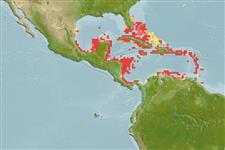Common names from other countries
Environment: milieu / climate zone / depth range / distribution range
Ecologia
marino associati a barriera corallina. Tropical; 32°N - 9°N
Western Atlantic: Bermuda, southern Florida in USA and Bahamas to Panama and Venezuela.
Size / Peso / Age
Maturity: Lm ? range ? - ? cm
Max length : 10.0 cm TL maschio/sesso non determinato; (Ref. 92840)
Spine dorsali (totale) : 7 - 8; Raggi dorsali molli (totale) : 13; Spine anali: 1; Raggi anali molli: 12. Whitish with a row of five dark yellowish brown double spots on lower side of body; head and dorsal part of body with irregular yellowish brown spots of variable; caudal fin with chevron markings (Ref. 13442); body is slightly elongate; ventral fins completely united (Ref. 92840).
Found on silty open bottoms (Ref. 9710). Shares burrow with alpheid shrimp, usually in open bottom in less than 9 m depth.
Life cycle and mating behavior
Maturities | Riproduzione | Spawnings | Egg(s) | Fecundities | Larve
Robins, C.R. and G.C. Ray, 1986. A field guide to Atlantic coast fishes of North America. Houghton Mifflin Company, Boston, U.S.A. 354 p. (Ref. 7251)
IUCN Red List Status (Ref. 130435)
CITES (Ref. 128078)
Not Evaluated
Threat to humans
Harmless
Human uses
Strumenti
Special reports
Download XML
Fonti Internet
Estimates based on models
Preferred temperature (Ref.
115969): 26.5 - 28.2, mean 27.5 (based on 534 cells).
Phylogenetic diversity index (Ref.
82804): PD
50 = 1.0000 [Uniqueness, from 0.5 = low to 2.0 = high].
Bayesian length-weight: a=0.01023 (0.00477 - 0.02194), b=3.02 (2.84 - 3.20), in cm Total Length, based on LWR estimates for this (Sub)family-body shape (Ref.
93245).
Trophic level (Ref.
69278): 3.4 ±0.55 se; based on food items.
Resilienza (Ref.
120179): Alto, tempo minimo di raddoppiamento della popolazione meno di 15 mesi (Preliminary K or Fecundity.).
Fishing Vulnerability (Ref.
59153): Low vulnerability (10 of 100).
